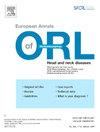scl - chep与内窥镜CO2激光cordecectomy治疗cT2N0M0声门鳞状细胞癌10年肿瘤学结果的对比STROBE分析
IF 2.4
4区 医学
Q2 OTORHINOLARYNGOLOGY
European Annals of Otorhinolaryngology-Head and Neck Diseases
Pub Date : 2025-07-01
DOI:10.1016/j.anorl.2025.04.006
引用次数: 0
摘要
目的:比较肩胛上部分喉切除术和环舌舌瓣会厌闭锁术(scl - chep)与CO2激光声带切除术(LC)治疗cT2N0M0型声门鳞状细胞癌(SCC)的10年肿瘤学结果。材料与方法:对1993-2013年在法国某大学耳鼻喉科连续治疗的57例分离性cT2N0M0声门SCC患者进行回顾性观察分析,其中scl - chep患者33例,LC患者24例。总的来说,93%和81%的患者分别随访了至少5年、10年或直到死亡。主要终点是10年精算总生存率和无病生存率。次要终点包括死因、10年精算局部对照和10年喉保留估计。结果:无论采用何种手术方式,10年生存率均为58%。SCPL-CHEP治疗后10年无病生存率为87%,LC治疗后为71% (P=0.15)。LC后出现3例SCC相关死亡,而scl - chep后未出现SCC相关死亡。10年局部控制率不同:SCPL-CHEP治疗后为100%,LC治疗后为65%,救助治疗后整体局部控制率为96%。SCPL-CHEP术后10年喉保存率为97%,LC术后为74% (P=0.03)。结论:对于cT2N0M0声门鳞状细胞癌被认为可以接受部分喉手术的患者,目前的长期数据应该引导头颈部外科医生讨论LC和scl - chep的益处和缺陷。本文章由计算机程序翻译,如有差异,请以英文原文为准。
A comparative STROBE analysis of 10-year oncologic results of SCPL-CHEP and endoscopic CO2 laser cordectomy for cT2N0M0 glottic squamous cell carcinoma
Objective
To compare 10-year oncologic results of supracricoid partial laryngectomy and cricohyoidoepiglottopexy (SCPL-CHEP) versus CO2 laser cordectomy (LC) for cT2N0M0 glottic squamous cell carcinoma (SCC).
Material and method
Retrospective observational analysis of an inception cohort of 57 patients with isolated cT2N0M0 glottic SCC consecutively managed at a French university teaching otorhinolaryngology department during the years 1993–2013: 33 with SCPL-CHEP and 24 with LC. In all, 93% and 81% of patients were followed for respectively at least 5 years, or 10 years or until death. The main endpoint was 10-year actuarial overall and disease-free survival. Secondary endpoints comprised cause of death, 10-year actuarial local control, and 10-year laryngeal preservation estimates.
Results
Ten-year survival was 58% whichever the surgical technique. Ten-year disease-free survival was 87% after SCPL-CHEP and 71% after LC (P = 0.15). Death related to SCC occurred in 3 patients after LC but was not encountered after SCPL-CHEP. Ten-year local control differed: 100% after SCPL-CHEP versus 65% after LC, with 96% overall local control after salvage treatment. Ten-year laryngeal preservation differed: 97% after SCPL-CHEP versus 74% after LC (P = 0.03).
Conclusions
In patients with cT2N0M0 glottic SCC considered amenable to partial laryngeal surgery, the present long-term data should lead head and neck surgeons to discuss the benefits and pitfalls of both LC and SCPL-CHEP.
求助全文
通过发布文献求助,成功后即可免费获取论文全文。
去求助
来源期刊

European Annals of Otorhinolaryngology-Head and Neck Diseases
OTORHINOLARYNGOLOGY-
CiteScore
3.70
自引率
28.00%
发文量
97
审稿时长
12 days
期刊介绍:
European Annals of Oto-rhino-laryngology, Head and Neck diseases heir of one of the oldest otorhinolaryngology journals in Europe is the official organ of the French Society of Otorhinolaryngology (SFORL) and the the International Francophone Society of Otorhinolaryngology (SIFORL). Today six annual issues provide original peer reviewed clinical and research articles, epidemiological studies, new methodological clinical approaches and review articles giving most up-to-date insights in all areas of otology, laryngology rhinology, head and neck surgery. The European Annals also publish the SFORL guidelines and recommendations.The journal is a unique two-armed publication: the European Annals (ANORL) is an English language well referenced online journal (e-only) whereas the Annales Françaises d’ORL (AFORL), mail-order paper and online edition in French language are aimed at the French-speaking community. French language teams must submit their articles in French to the AFORL site.
Federating journal in its field, the European Annals has an Editorial board of experts with international reputation that allow to make an important contribution to communication on new research data and clinical practice by publishing high-quality articles.
 求助内容:
求助内容: 应助结果提醒方式:
应助结果提醒方式:


